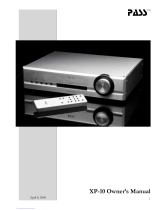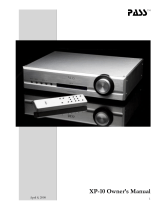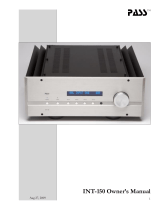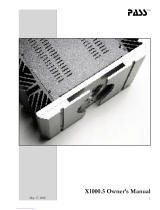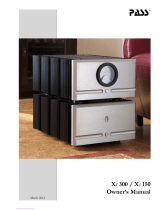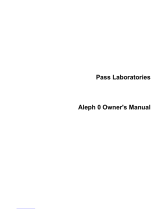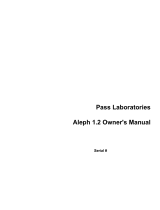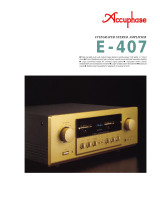Page is loading ...

1
X0.2 Owner’s Manual
pass
TM
X0.2 Owner’s Manual
May 18, 2006

2
X0.2 Owner’s Manual
The X0.2 is an ultra high quality three chassis line-stage audio
pre-amplifier featuring remote control and internal power supply.
It combines a completely new circuit topology with traditional
construction representing thirty five years of preamplifier design.
This pre-amplifier flows from a commitment to create the best
sounding product: a simple circuit with the most natural sonic
characteristics. Derived from US Patent # 5,376,899, the X0.2
integrates power MOSFET and JFET devices in a simple Class A
topology in order to deliver the finest sound possible.
The Super-Symmetric gain circuitry used in the X0.2 is unique in
providing superior flexibility and performance with both balanced
and unbalanced inputs and outputs, converting one to the other as
desired without extra circuitry and without performance degradation.
The X0.2 minimizes the number of components in the signal path,
and yet retains exemplary objective performance specifications. It
pushes the edge of the art in exploring how much subjective quality
is obtainable with a new but very elementary gain stage.
The X0.2 employs a patented new type of volume control that
offers significantly better performance than seen before in an
electronic control. It provides over 60 dB of range, large voltage
swing and very good measured performance. The distortion and
noise is at 1/10 and the dynamic range 100 times the previous state
of the art in active attenuation. Most importantly it is subjectively
outstanding; better than any potentiometer we have evaluated.
The fluorescent display is a very special device. Not only will you
find its blue color highly attractive and readable, it is far more reliable
than the usual LED or LCD display.
Very few people are involved in the production of this product. I
supervise all phases of the construction, and I test each pre-amplifier
myself. If you have questions, comments, or problems, please feel
free to contact me directly.
Thank you for purchasing this pre-amplifier. It is my sincere hope
that you will enjoy its sound as much as I do.
Wayne Colburn
Vice President, Design
Introduction

3
X0.2 Owner’s Manual
The pre-amplifier consists of three machined aluminum chassis; it
has five sets of input connections, two sets of outputs, both single-
ended and balanced, a tape loop and a full function remote control
unit that mirrors the front panel functions.
The power supply control chassis has a 5-way binding post that is
used for remote amplifier turn-on. The pre-amplifier’s voltage and
current rating are indicated by the affixed tag on the bottom of the
pre-amplifier’s power supply control chassis. This tag will indicate
either 240 volts, 220 volts, 120 volts, or 100 volts. A 0.5 amp 3AG
slow blow fuse is provided with 100-120 volt units, and a 0.25 amp
slow-blow fuse is provided with 220-240 volt units. The frequency
rating of the X0.2 power supply is 50 to 60 Hz. This pre-amplifier
typically draws 30 watts during operation. Please verify that the input
power rating as indicated on your unit is consistent with that supplied
in your area before attempting hook up.
The remote control is powered by two (2) factory installed AAA
batteries.
The individual gain channels connect to the power supply control
unit with four (4) necessary cables and to each other with one
optional cable. These cables must be installed before the
preamp is powered up. The cable jacks are clearly labeled on
the rear of each chassis and are style and gender specific so as to
minimize opportunity for mis-connection.
Both gain channels are identical electrically, the only difference is the
color of the identifying rings under the RCA connectors. The right
channel is identified by red rings under the RCA’s connectors and
the left by white rings. Additionally the right gain stage chassis has a
female XLR marked “mono” and the left gain control chassis has a
male XLR marked “mono” as a further identifier.
The X0.2 takes maximal advantage of four identical gain paths
(two identical paths per channel) very much unlike the typical two
gain path (one signal path per channel) pre-amplifier you may be
familiar with. Almost without exception traditional consumer audio
pre-amplifiers, unlike their science and industry counterparts have
maintained a single signal path per channel (two identical aths in a
stereo pair).
In order to manage balanced signals these two gain path pre-
amplifiers must utilize phase combining networks to process
incoming signals and subsequently drive outputs via phase splitting
circuits to re-establish a quasi-balanced signal. This manipulation of
Setup

4
X0.2 Owner’s Manual
signal typically adds additional gain stages and degrades the inherent
noise and distortion superiority of balanced signal, coloring what you
eventually hear.
Pass Labs, through its unique patented “Supersymmetry” topology,
maintains the advantages of a true balanced signal throughout
the electronics chain. The salient point of this approach affords
significantly less signal manipulation, higher input impedance, as
much as a 100:1 (20dB) reduction in distortion while providing
greater gain, and twice the dynamic headroom of identical circuits
running single ended.
The X0.2 maintains the integrity of its received signal by treating
all sources internally as balanced signals and converts seamlessly
between balanced and unbalanced inputs and outputs without any
additional components in the signal path. This was a conscious
effort by Pass Labs to enhance the consumer’s ability to integrate
source components and power amps with otherwise incompatible
requirements through a virtually transparent control center.
It is not absolutely necessary to have the “mono” cable installed
between these connectors unless you plan to operate the X0.2
in mono mode. You may use our supplied “mono” cable or an
aftermarket male - female XLR of your choosing. If you choose an
aftermarket cable, length should be consistent with the placement of
your equipment and not excessively long.
The DIN connectors plug into their mating jacks and then screw into
the rear panel on all three chassis. These connectors are intentionally
a snug fit, but should never be forced. The single unmarked DIN
jack on the right rear of the power supply control chassis is currently
unused, we have reserved it for future performance enhancements.
We have provided a standard IEC AC power cord that fits into the
IEC line receptacle at the rear of the pre-amplifier power chassis.
The pre-amplifier is equipped for operation with an earth ground
provided by the user’s AC outlet. Do not defeat this ground. The
chassis and circuit ground of the pre-amplifier are connected to earth
through a power thermistor, which gives a ground connection for
safety but helps avoid ground loops.
As a safety issue we suggest that the power cord should be
the last cable installed on your pre-amplifier. The power
cord should be attached to the pre-amp power supply prior to
plugging into “house power.”

5
X0.2 Owner’s Manual
There are a total of five inputs, a separate tape loop and two outputs
on each of the pre-amplifier chassis. One chassis is exclusively
dedicated to right channel and the other exclusively left channel.
Balanced inputs and outputs are via XLR connectors. Single-
ended inputs and outputs are via RCA connectors. On the XLR
connectors, pin 1 is grounded, pin 2 is the positive signal, and pin 3 is
the negative signal.
If your signal source is unbalanced, input will occur through
the RCA input connectors, which are in parallel with the XLR
connections. When single-ended inputs are used, a shorting jumper,
which is provided, should be inserted between pins 1 and 3 of the
corresponding XLR connection. The supplied jumpers short the
negative input to ground, and provide for optimal performance. The
X0.2 preamplifier will function without these jumpers, but gain will
be lower and performance will not be optimal.
The unbalanced input impedance of the pre-amplifier is 10K Ohms.
In balanced mode, the input impedance is higher, with a differential
impedance of at least 20K Ohms.
Next to the inputs on the rear panel of the gain stages, the pre-
amplifier offers tape inputs through both XLR and RCA connectors.
This output is a direct connection to inputs 1, 2, 3, 4 and 5 when they
are selected from the front panel. Input 6 (TAPE IN) is deliberately
not available through the tape output connection. Tape input is
designated for use with a tape recorder if you have one, and we have
arranged that it will not place its output on the tape out, which will
prevent you from accidentally creating a feedback connection with
your tape machine.
The main outputs are located left-hand of center (viewed from the
rear) of the rear panel, two male XLR connectors, and two RCA
connectors. The RCA connectors’ ground is in parallel with pin 1
of the XLR outputs, and the RCA hot is fed from an independent
summing junction that maximizes the X circuit benefits. The RCA,
single-ended, outputs are buffered from the balanced outputs.
In an effort to accommodate a wide range of equipment we have
configured this product so that you may use both single ended and
balanced outputs at the same time. On the XLR, pin 1 is ground, pin
2 is positive output, and pin 3 is negative output.

6
X0.2 Owner’s Manual
In application the X 0.2’s front panel controls and alphanumeric
display are quite straight forward, and intuitive. We encourage you
to become familiar with their operation prior to establishing any
input connections with this unit. Experience indicates that engaging
in a few minutes of exploration and playtime will add much to your
ultimate enjoyment of this exceptional Pass Labs product.
The two front panel mode switches move the pre-amplifier and its
display through 9 different functions. From virtual left to virtual
right these functions are as follows: Volume, Input, Mute, Tape,
Balance, Display, Mono, Unity, Amp (power-amplifier turn on/off
control). Actuating the mode < switch moves the function to the
feature immediately to the virtual left, and conversely actuating the
mode > switch moves the function to the feature that is immediately
to the virtual right.
The two Select switches (designated by up and down pointing
arrows) then alter the displayed active function. The select arrows
toggle the following functions either off or on (the up pointing
arrow ^ representing “on” and the down pointing arrow v
representing “off ”) Mute, Tape, Mono, and Amp.
The leftmost function as selected by the two mode switches is
volume, and the up/down arrows select 72 steps incrementally,
indicated on the fluorescent display as 0 - 71. A more traditional
knob, located at the far right of the front panel, which is always
active, exactly duplicates this control function. Each step is
approximately 1 dB of incremental change.
The next mode to the right is the input selector, for inputs 1 through
5. Input 5 is unique in that it is linked with the Unity function. (The
UNITY FUNCTION is discussed at length later in this manual.)
The two select arrows (^ & v) logically control selections of the
various inputs to the pre-amplifier.
The channel balance function is affected by the up and down arrows.
The up arrow is balance right and the down arrow conversely balance
left.
The display function chooses one of three iterations of brightness
for the front panel fluorescent display. These choices of display
brightness are selectable by the up/down arrows; they are bright, dim
and off.
The unity function bears special attention. This control is associated
only with input number 5 and has two positions selected with the
Description of Operation

7
X0.2 Owner’s Manual
up/down arrows. The up arrow toggles to a straight through function
with neither attenuation nor gain. This function is useful in that it
allows the pre-amplifier to function as a unity buffer for use with
components that best function with their own volume controls, such as
surround processors. When the right-front and left-front outputs of
the processor are routed through input 5 of the X0.2 (with the gain of
the X0.2 set for Unity gain), the volume will be under full control of
the processor and the X0.2’s action will be totally transparent. When
the user chooses Unity this sets the X0.2’s gain to the straight through
0dB setting, regardless of how it was previously configured. When
at “Unity” both left and right level controls on the X0.2 will have a
displayed value of 54, and any previous balance settings will be lost.
Both of these default conditions are intentional, and intended to make
the most advantageous use of your source electronics. You may also
set any of the four inputs to unity (0dB gain) by manually setting the
volume of that input at 54.
Before selecting this option, it is imperative that the input device
on input number 5 have its gain set to minimum. Failure to
follow this precaution could result in a volume level intolerable
to both ears, speakers and bank account. We trust that the remote
control, with its four buttons that duplicate those of the preamp front
panel will enable you to quickly select inputs and establish levels of
output.
The rear mounted pair of five-way binding posts on the power supply
/ control unit are intended to actuate the remote on/off function of
our own X series power amplifiers from the X0.2 front panel, or via
the four button remote. When the preamp mode “Amp” is selected
it allows the user to switch a nominal 12 volts DC at maximum draw
of 50 milliamps to these binding posts. In some instances this voltage
may have the ability to control products from other manufactures,
but we by no means have a comprehensive listing of their compatible
features. If you have questions about compatibility your service
technician and dealer are an excellent source of information. This
setting has no “default” condition, it maintains the last setting chosen
by its user.
The remote control uses the same four-button system as the front
panel controls, but in a slightly different physical configuration. The
far left button is mode < left the far right button is mode > right.
The top button is select ^ up and the bottom is select v down. The
main chassis display shows the active function. The display has two
brightness levels and off. If any control is used the display reverts to
its dim setting. The off mode shows the display for about 7 seconds
and then turns off.

8
X0.2 Owner’s Manual
The electronic volume control allows greater than 70 dB range and
is driven by a micro-controller that reads the optical encoder which
serves as a front panel volume control. In this manner tracking of
the volume for the two balanced channels is possible with accuracy
unavailable on any ordinary volume control, assuring precise level
steps and high common mode rejection in balanced circuits. Wayne
Colburn’s exceptional volume control, in conjunction with the
fluorescent display, give the user the ability to replicate volume levels
with absolute accuracy in steps of roughly 1dB.
1) Circuit simplicity and a minimum number of components is a key
element. The fewer parts in series with the signal path, the better.
Adding more parts and gain stages may improve measured specs,
but will seldom improve the perceived sonic quality or reliability of a
product.
2) The characteristic of gain devices and their specific use is important.
Individual variations in performance between like devices are
important, as are differences in topological usage. All signal bearing
devices contribute to the degradation, but there are some different
characteristics that are worthy of attention. For example, smooth low
order nonlinearities are additive in quality, bringing false warmth and
coloration, while abrupt high order nonlinearities add harshness and
false brightness.
3) Maximum intrinsic linearity is desired. This is the performance of
the gain stages before feedback is applied. Experience suggests that
feedback is a subtractive process; it removes information from the
signal. In many older designs, poor intrinsic linearity has been corrected
out by large application of feedback, resulting in loss of warmth, space,
and detail. The trick is to get good performance without this excessive
reliance on feedback.
The art of high-end audio design lies in the approach to combining
these elements to get high reliability and simplicity, high quality
measured performance, and high quality subjective performance. It
takes imagination and hard work to get as much of these as possible at
once without trading them off against each other.
We recommend the use of the balanced output mode where possible.
It will retain the character of the input mode, but offers less distortion,
less noise, more gain, and more voltage swing, without compromising
the sound.
Product Philosophy
Other Design Comments

9
X0.2 Owner’s Manual
With balanced operation, the common mode rejection of the preamp
reflects the intrinsic common mode rejection of the topology, the
matching of the gain devices, and the matching of the attenuator
channels. In this case we have been able to keep the total mismatch to
about .1%, for a common mode rejection of greater than -60 dB.
The input system of the pre-amplifier will exhibit full common mode
noise rejection with passive balanced sources, where the negative input
is connected to ground at the source through the appropriate source
impedance. This allows adaptation of unbalanced sources to balanced
operation with passive cable connections in a manner that achieves the
noise rejection of active balanced sources.
The use of a micro-controller allows all of the pre-amplifier functions
to be repeatable and accurately controlled. The micro-processor only
controls the operational functions of the pre-amplifier. At no time do
any of the input or output signals come into contact with the digital
control signals. The digital circuits are powered by a power supply that
is completely separate and isolated from the analog supply. Should it
ever be necessary to update the software that controls the functioning
of the preamp, only the socketed micro-processor need be changed.
The analog power supply for the X0.2 consists of a toroidal power
transformer delivering an unregulated +/- 45 volts which is then
actively regulated before feeding passive filtering and powering the
constant current sources which bias the gain stages. Each channel has
its own regulation. The power supply noise reaching the circuit is
on the order of one microvolt, and the little of that which gets through
the circuit is differentially rejected at the output in a balanced system.
The relays and control systems are regulated independently. All digital
circuits receive their power from a separate toroid, which, like its analog
counterpart, is also double regulated, and carefully filtered.
Muting relays, which delay connection during turn-on, additionally
shut off the output when insufficient power supply is available to
maintain regulation, thus guarding the output of the pre-amplifier. The
pre-amplifier is designed to run constantly, and will exhibit optimum
measured performance within about 10 hours of turn-on. For this
reason a power switch is intentionally omitted.
The X0.2 consists of three machined aluminum chassis. Likewise, the
remote control device is ensconsed in its own palm sized aluminum
chassis. All four chassis components are machined from solid aluminum
material on computer controlled vertical milling machines. There are
no sheet metal components is this product. All engraving is done by
laser to make it easy to read and provide a durable and attractive finish.

10
X0.2 Owner’s Manual
All figures obtained after 1 hour warmup, with regulated 120 VAC
power line. See manual notes about AC power line regulation.
Gain, Balanced 12 dB Bal in, Bal output
Gain, single-ended 12dB unbal in, unbal output
Freq. Response -3 dB @ 2 Hz
-3 dB at @ 100 kHz
Distortion @ 1KHZ < .1 % THD, typ .003% @ 2v
Maximum Output 20 volts rms bal out
7 volts rms unbal out
Output Impedance 200 ohms unbalanced
750 ohms balanced
Input Impedance 10K ohm unbalanced
20K ohm balanced
CMRR typ. -80 dB, 20 - 20kHz
Crosstalk typ. -90 dB, 20 - 20kHz
Output Noise floor < -110 dBV, 20 - 20kHz
Extl amp turn on 12 volts DC 50 mA continuous
Power Consumption 35 watts
Dimensions 17” W x 3.5”H x 13 “D each
Shipping Weight 70 pounds in packing carton,
3 units
For more information please contact:
Pass Laboratories Inc.
P.O. Box 219,
24449 Foresthill Rd.,
Foresthill, CA 95631
Tel: 530.367.3690
Fax: 530.369.2193
www.passlabs.com
© 2006 Pass Laboratories Inc.
X0.2 Specifications
“Pass”, “pass”, “Pass Labs”, “Pass Laboratories”, Supersymmetery”,
“Aleph”, and “Zen” and are all registered trademarks of Pass
Laboratories, Inc., and all rights thereto are protected by law.

11
X0.2 Owner’s Manual
Please check with the factory-authorized distributor in the country you are
purchasing this product for specific warranty information.
All Pass Laboratories products purchased from an authorized Pass Labora-
tories dealer in North America are covered by a transferable, limited 3-year
warranty. This warrantee includes all parts and labor charges incurred at the
repair facility in addition to return shipping to the domestic customer, exclu-
sive of subsequent damages. Damage due to physical abuse is specifically
not covered under this warranty.
For this warranty to apply the customer is responsible for returning the
product unmodified to the factory within the warranty period. The customer
assumes all responsibility for shipping and insurance to the factory or a fac-
tory specified repair facility. The conditions and stipulations of this Pass
Laboratories warranty only applies to units sold new in North America.
Non-North America customers should consult with their original Pass Labs
dealer or distributor for warrantee repair instruction prior to contacting the
factory or shipping product for repair.
Non-North American product must be returned to the country of origin for
warrantee service. Foreign distributors are only required to offer warranty
service on Pass Laboratories product that they have imported.
Please note: Conditions of warranty service and customer rights for product
purchased outside the United States may vary depending upon the distribu-
tor and local laws. Please check with your local distributor for specific rights
and details.
Any modifications to Pass Laboratories products that have not received
written factory approval nullify all claims and void the warrantee. Should a
modified product be returned to the factory for repair the owner will be re-
quired to pay all necessary charges for the repair in addition to those charges
required to return the product to it’s original configuration.
In the case of safety issues, no product shall be returned to the customer
without those safety issues being corrected to the most recent accepted
standards.
Removal or alteration of original Pass Labs serial numbers voids the factory
warranty. Product with altered or missing serial numbers will be suspected
as counterfeit product.
Pass Laboratories will not repair or in any way indemnify any counterfeit or
cloned product.
Pass Laboratories does not offer products in voltages intended for inter-
national markets either to authorized Pass Labs dealers or to third parties
located in the United States or Canada.
Warranty Information

12
X0.2 Owner’s Manual
Water and moisture: Electrical devices should not be used near
water ( as per example, near a bathtub, washbasin, kitchen sink,
laundry tub, wet basement or swimming pool ). Care should be
taken such that objects do not have the opportunity to fall, and that
liquid is never spilled onto or into the device enclosure through
openings.
Power Sources: An electrical device must be connected to a mains
power source in strict accordance with the supplied product owner’s
manual. Please verify that the AC mains voltage specified in the
product manual matches those requirements indicated on the unit
and the AC voltage provided to your location by the power company.
Grounding: Adequate precautions should be taken so that the
grounding provisions built into an electrical product are never
defeated.
Power Cords: Pass Laboratories provides a power supply cord that
meets all legislated requirements for the market in which the product
was originally sold. If you choose to substitute an after-market
product we urge you to choose one that is fully safety rated by the
necessary local authority.
Power Cord Protection: Power supply cords should be routed so
that they are not likely to be walked on, abraded, or pinched by items
placed on or against them, paying particular attention to cords where
they enter plugs or exit from a device. Never under any circumstance
insert a cut or damaged power cord into a mains power socket.
Power and Signal: Cables should never be connected /
disconnected with equipment powered up. Failure to heed this
warning may damage or destroy equipment.
Ventilation: Power-amplifiers run hot, but you should be able to
place your hands on them without discomfort. You must allow for
this heat in installation, by providing for free air circulation around
the product. Electronics should not be subjected to sources of
excessive radiant heat. Excessive heat can shorten the life of the
product and may cause the electronics to self-protect and shut down.
Servicing: To reduce the risk of fire, electrical shock or other
injuries, the user should not attempt to service the device beyond
that which is described in the operating instructions. All other
servicing must be referred to qualified service personnel.
For your protection please
read the following:
/

